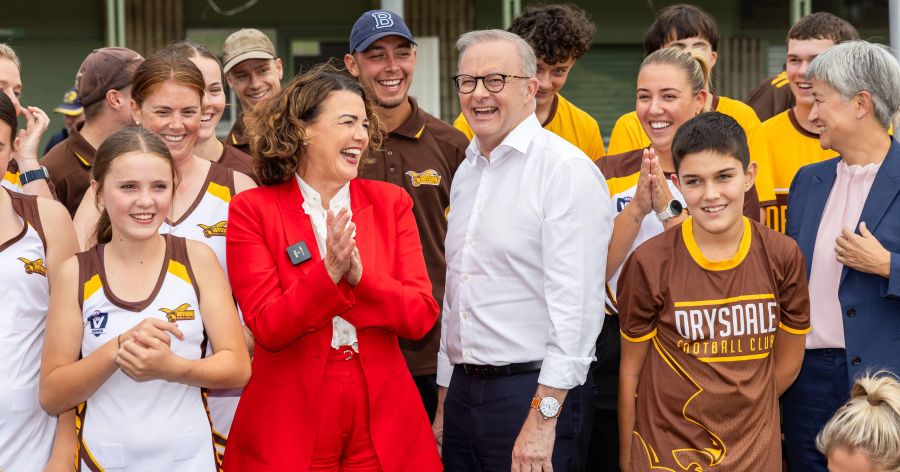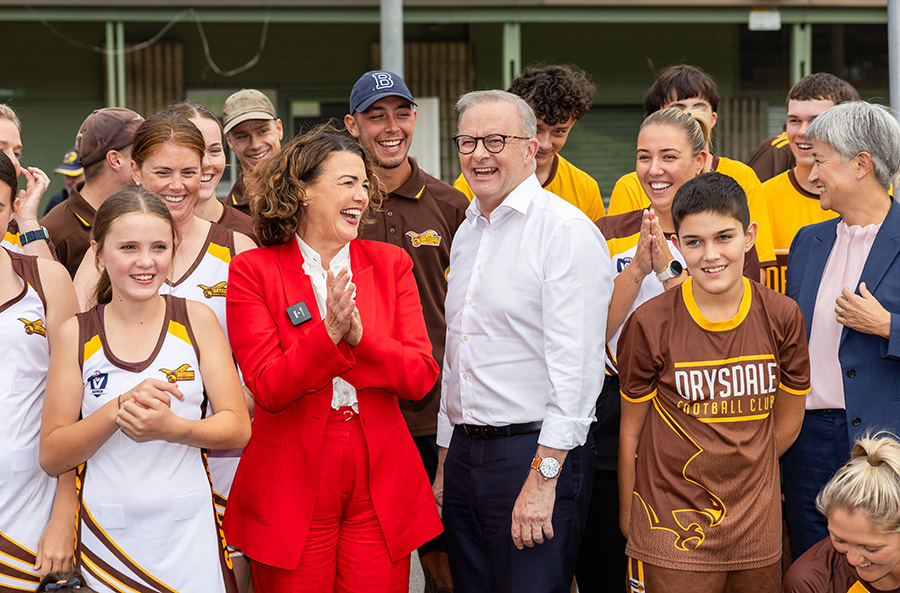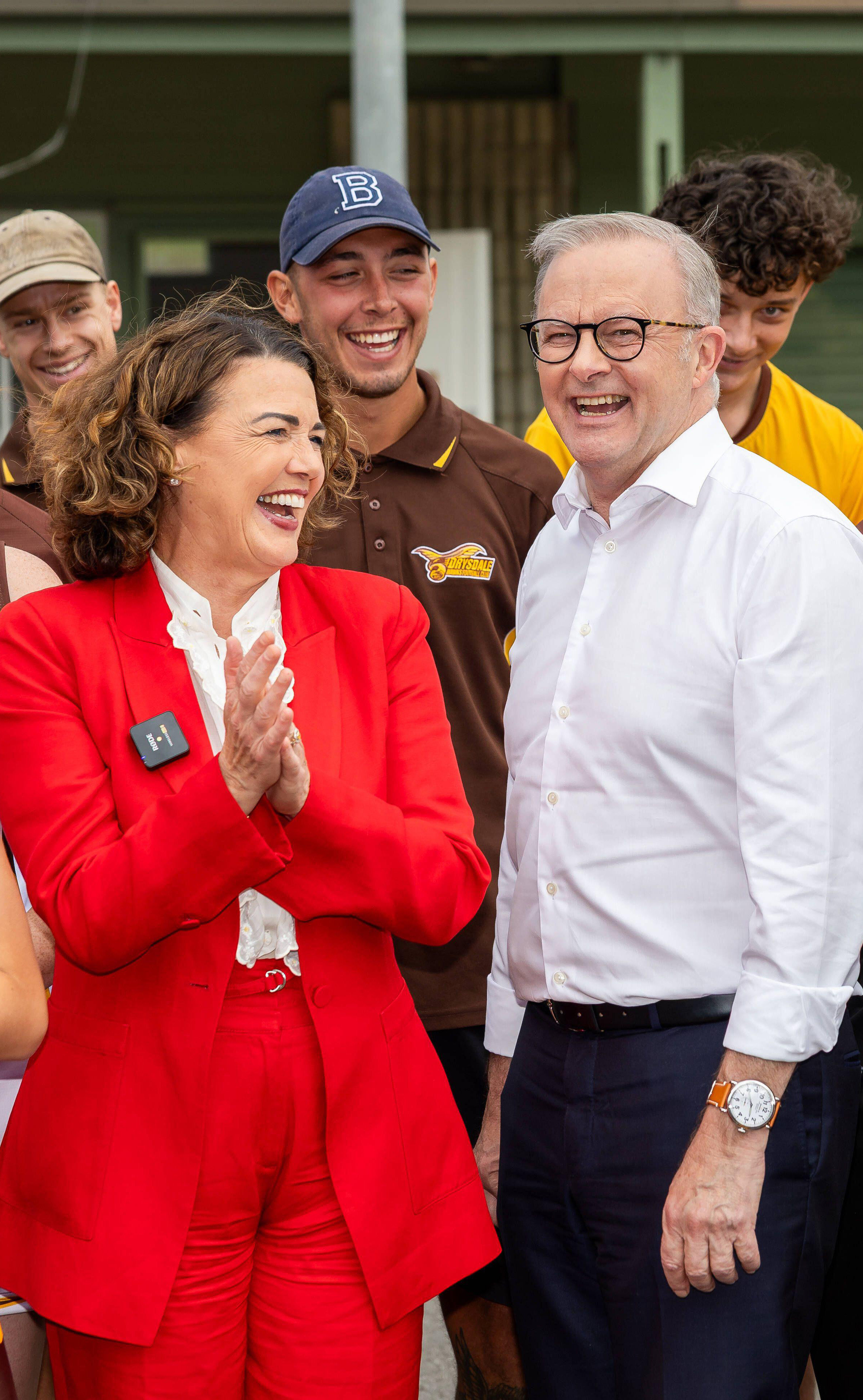
- Free Article: No
- Contents Category: Commentary
- Custom Article Title: A bullet with butterfly wings: Precarity obscured by an emphatic federal election result
- Review Article: No
- Article Title: A bullet with butterfly wings
- Article Subtitle: Precarity obscured by an emphatic federal election result
- Online Only: No
- Custom Highlight Text:
Last month’s remarkable federal election result has produced a metric plethora of articles explaining how it was achieved and what it means for the government, for the electorate, and for elections to come.
- Featured Image (400px * 250px):

- Alt Tag (Featured Image): ‘A bullet with butterfly wings: Precarity obscured by an emphatic federal election result’ by John Byron
I do not mean that Labor didn’t earn this electoral victory. They ran an excellent campaign, led by Prime Minister Anthony Albanese, masterminded by National Secretary Paul Erikson, fronted by campaign spokesman Jason Clare, and delivered by a rotation of frontbenchers. I worked on three election campaigns for federal Labor within the office of Senator Kim Carr and this is easily the most comprehensive operation I have witnessed.
Indeed, the main banana skin of the campaign was a wilful, confected misreading of the prime minister’s words after he stepped into the air off a stage. When the prime minister said he didn’t fall, he meant that he didn’t hit the deck – though a league man, he has clearly watched enough rugby union to place a high value on keeping his feet. When that is the worst blunder in a five-week campaign trail, it can be said to have gone well.
Yes, the government had the wind at their backs. Most notably, the Opposition’s lack of policy preparation and poor shot selection played Labor’s way almost every day of the campaign, and US President Donald Trump’s second-term rainmaking was perfectly timed to make Australians think twice about the merits of right-wing populist rhetoric.
The final Australian Electoral Commission (AEC) results are not yet in at the time of writing, but the media are predicting that the Albanese government will win at least ninety-three of the 150 seats in the House of Representatives. That eclipses the achievements of the Labor pantheon, including Gough Whitlam, Bob Hawke, Paul Keating, and Kevin Rudd. It surpasses Jim Scullin’s forty-six out of seventy-five in 1929 and is second only to John Curtin’s forty-nine from seventy-four seats in 1943 – equivalent to winning ninety-nine seats in the current House.
The sheer scale of Labor’s domination of this forty-eighth Parliament brings its own risks. Complacency is not one of them; many in the Labor caucus endured the indignity of early banishment to opposition after the Rudd-Gillard-Rudd era, with its unedifying infighting and constant upheaval, and now cherish the privilege of governing.
The real danger for Labor is in misreading that sweep of red, which will overwhelm the combined presence of the former Coalition partners and the cross-bench. To the naked eye it will look like conclusive occupation of enemy terrain. This sense of dominance is amplified by media commentary, which tends to characterise such majorities as territory won in a martial sense, placing the battlefront a long way forward of the critical midpoint at which the right to govern might be threatened.
The trouble with the territorial metaphor is that it no longer captures the nature of the electoral contest; the lopsided seat differential simply does not represent a steady gradient of buffer seats, as it once did. Nor does the two-party-preferred margin accurately reflect the underlying vulnerability of many individual seats, as primary votes for the major parties plummet and competitive minor parties and independents proliferate. As the kids say, there is no such thing as a safe seat anymore.
While the media loves reporting them, national sentiment and uniform swings are worse than meaningless – worse, because they imply predictive power they do not possess. That methodological truth was concealed throughout the twentieth century and into the twenty-first by the dominance of the two-party trend in all but a handful of seats. While Labor has more than twice as many seats as the Coalition, the government’s primary vote is not much greater than their opponents’ and only slightly more than the rest of the contenders put together. We now live in non-binary times, and the expansion of the crossbench has revealed what has always been the case; that the House of Representatives is the sum of its 150 parts.
The only insights into elections that matter are those derived from painstaking seat-by-seat inspection and analysis, right down to individual preference flows. To retain credibility, future political race-calling should concentrate on predicting seats out of 150, not a binary percentage. It must, in short, look beyond the primary sentiments because the several dozen seats that will determine election results from now on will go down to the preferential wire.
With many electorates manifesting the approximate national primary split of one-third Labor, one-third Coalition, and one-third others, any movement of preferences can start to produce large effects from relatively minor shifts in voter behaviour. Once the primary vote in a seat gets down to one third, the effects of erratic preference flows become much more influential, pushing trailing candidates above leaders in the closing rounds of preference distribution with a handful of votes. Nick Evershed of The Guardian characterises the three-way balance of the primary vote as largely symbolic; Phil Coorey of the Australian Financial Review claims the Opposition is mathematically incapable of winning the next election. Both claims are wrong. This is the most meaningful development in electoral calculus in years, and it is backed up by chaos theory.
The Butterfly Effect is one of science’s more popular metaphors, up there with Schrödinger’s Cat. It is a parable about sensitivity to initial conditions, where a tiny early alteration – a handful of votes going left instead of right, say – can lead to a large change in a later state, enough to push a third candidate into second place, and thus reap most of the excluded preferences and win.
The upshot is that prediction becomes impossible, even in a deterministic system, because early differences below the level of resolution can change the entire outcome. This is not about randomness, although random factors can intrude (such as the order of candidates on the ballot sheet); nor is it about margins of error, since this is an effect in the ballot itself, not in a poll that is attempting to model voter intention. It is a ghost in the preferential machinery above a certain level of complexity, emergent in the absence of clear contest leaders who swamp the effect with sheer numerical power.
With so many seats hovering around this roughly even three-way primary split – enough, at any rate, to determine the outcome of an election – the lower house ballot now exhibits an inherently unpredictable sensitivity to initial conditions that could turn vast swathes of red seats blue, green, or teal with only minor movements in the starting conditions. A modest decrease in the primary vote, or a slightly less favourable preference position below the primary, and a seat can quickly reach a tipping point and collapse.
The limit case in this election is the electorate of Calwell, with its thirteen candidates, nearly half of whom remain possible winners at the time of writing. Looking more like a senate seat, Calwell is so complex that it is going to a full distribution count. There is no way to know who has won until all the counting is done, and the AEC cannot begin that full count until every single valid vote is received. As I write, the bottom seven candidates have between them a higher primary vote than the current runner-up. It is possible that a candidate with a primary vote in single figures could win Calwell. The sensitivity to initial conditions here is exquisite.
 Libby Cooker and Anthony Albanese, Drysdale, 2025 (Imago/Alamy)
Libby Cooker and Anthony Albanese, Drysdale, 2025 (Imago/Alamy)
Given the nature of the voting trends that delivered this new House of Representatives and that are likely to deliver the next few, wild swings could happen in many seats at once. This effect explains this emphatic result; most of Labor’s cards fell the right way, but they didn’t have to tip far. By the same logic, there is no buffer that will save a government from a wipeout if the cards fall the wrong way, with small movements in initial conditions that used to be considered negligible. With our electoral system in this state of equipoise, we will begin to see minor shifts in voter sentiment turn over enough seats to bring down governments.
So what does all this mean for parties, independents, and the second Albanese government?
For candidates, it means that improving their primary ‘take’ is no longer enough. They must now also improve their harvest of preference flows. While preference deals between parties always get the headlines, many voters do not follow how-to-vote cards. Candidates now need to present themselves as the next best thing, and certainly preferable to their likely rivals. That means even more doorknocking, even more listening, and even more responsive policy development.
The electorate’s tactical waywardness is here to stay. The best hope for the established parties – and I include the Greens in this, their cheerful ‘How do you do, fellow kids?’ approach notwithstanding – is not to try to game the system or trick people into voting for them. It is to do their homework and arrange their policy offerings such that enough of these rebellious voters will find it strategic to offer them their primary vote, or at least their first meaningful preference after the pleasures of protest voting have been savoured.
All the above applies to Labor, with the crucial difference that they are in possession of the tools and platform to best implement this new approach. By addressing one of the reasons for drift to fragmentary voting – the alienation and disaffection experienced by citizens – the party could shore up its delicate underlying vote and reduce its exposure to the unpredictability of initial conditions. It should take the electorate into its confidence and allow it to become more involved in decision making.
The government must get on with tackling the hard work of structural change that the entire country knows is overdue – on climate and energy, housing and tax, productivity, Closing the Gap, AUKUS, gendered violence, and on the sustainability of the health and education systems. It should be more candid about these diabolically interconnected problems, and present solutions informed by expert advice that is respected and accepted. In short, it should initiate a mature conversation with the nation about how to address major issues, sensibly and collaboratively, with an eye to long-term effectiveness as much as short-term palatability.
Governments don’t own political capital – they only borrow it. And they are expected to return it with interest. They can afford to spend a little here and there, but mostly they have to invest it.
If Labor doesn’t have a hard look at how it can consolidate its position, it may get a rude shock at the next election, because the Coalition, the Greens, the Teals and the many independents who just missed out will be coming back again, with fresh thinking and a new approach – alive to the possibilities that the electorate’s new voting tendencies now present.
This is one of a series of ABR articles funded by the Copyright Agency’s Cultural Fund.



Comments powered by CComment